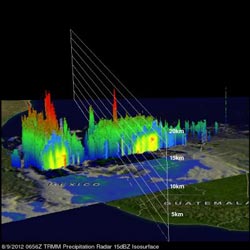NASA sees very heavy rainfall within Tropical Storm Ernesto

NASA's TRMM satellite saw tropical storm Ernesto on Aug. 9, 2012, at 0656 UTC. This 3-D view of Ernesto's vertical structures shows some powerful convective storms near Ernesto's center were pushing to heights of over 16 kilometers (~9.94 miles).<br><br>Credit: NASA/SSAI, Hal Pierce<br>
The TRMM satellite saw tropical storm Ernesto on August 9, 2012 at 0656 UTC (2:36 a.m. EDT) after it moved from the Yucatan Peninsula into the Gulf of Mexico. An analysis of TRMM Microwave Imager (TMI) and Precipitation Radar (PR) rainfall shows that powerful convective thunderstorms were dropping rain at a rate greater than 50mm per hour (~2 inches) north of the storm's center.
TRMM Precipitation Radar (PR) data were used to create a 3-D view of Ernesto's vertical structure. The PR view shows that a few of the powerful convective storms near Ernesto's center were pushing to heights of over 16 kilometers (~9.94 miles). The energy released by these storms near Ernesto's center can be a sign of intensification.
At 10 a.m. EDT on August 9, the National Hurricane Center noted that Ernesto's center was located very close to the coast, or already on land, near 18.2 North and 94.3 West. Ernesto's maximum sustained winds are near 60 mph (95 kmh) with higher gusts, but as Ernesto moves inland it is expected to weaken. Ernesto is moving west near 10 mph (17 kmh) and will move over southern Mexico over the next two days.
A Tropical Storm Warning is in effect from Veracruz to Chilitepec today, August 9. The National Hurricane Center expects the heavy rainfall that NASA's TRMM satellite identified to bring between five to 10 inches of rain, locally up to 15 inches, over the Mexican states of Tabasco, Veracruz, Puebla and Oaxaca. Flash floods and mudslides are a concern with these large amounts of rainfall. In addition another one to two inches of rain are possible over northern Guatemala and the southwestern Yucatan Peninsula.
A visible image of Tropical Storm Ernesto was captured from the Moderate Resolution Imaging Spectroradiometer (MODIS) instrument on NASA's Terra satellite, on August 8, when it was over the Yucatan Peninsula, and before it emerged into the Gulf of Mexico. To see that image, visit: http://tinyurl.com/9cuufa7
Media Contact
More Information:
http://www.nasa.govAll latest news from the category: Earth Sciences
Earth Sciences (also referred to as Geosciences), which deals with basic issues surrounding our planet, plays a vital role in the area of energy and raw materials supply.
Earth Sciences comprises subjects such as geology, geography, geological informatics, paleontology, mineralogy, petrography, crystallography, geophysics, geodesy, glaciology, cartography, photogrammetry, meteorology and seismology, early-warning systems, earthquake research and polar research.
Newest articles

Why getting in touch with our ‘gerbil brain’ could help machines listen better
Macquarie University researchers have debunked a 75-year-old theory about how humans determine where sounds are coming from, and it could unlock the secret to creating a next generation of more…

Attosecond core-level spectroscopy reveals real-time molecular dynamics
Chemical reactions are complex mechanisms. Many different dynamical processes are involved, affecting both the electrons and the nucleus of the present atoms. Very often the strongly coupled electron and nuclear…

Free-forming organelles help plants adapt to climate change
Scientists uncover how plants “see” shades of light, temperature. Plants’ ability to sense light and temperature, and their ability to adapt to climate change, hinges on free-forming structures in their…





















